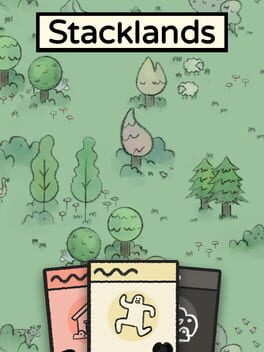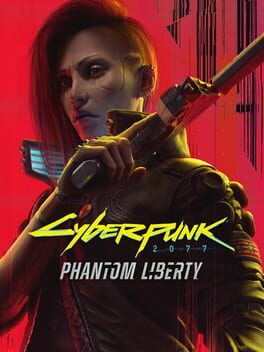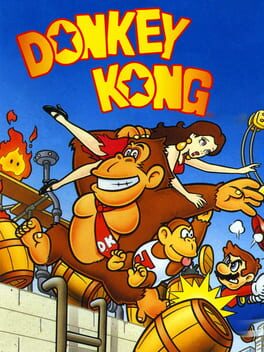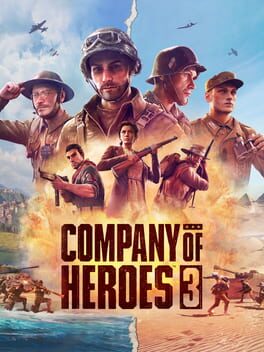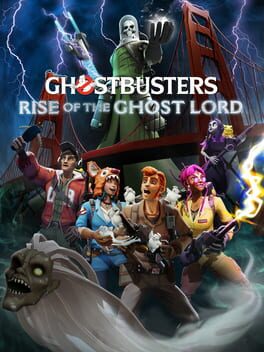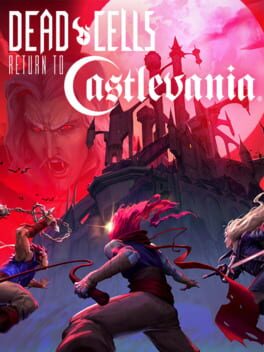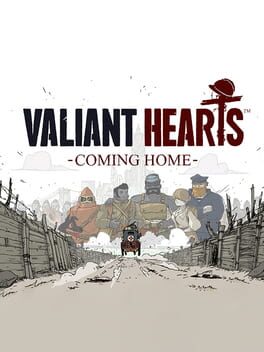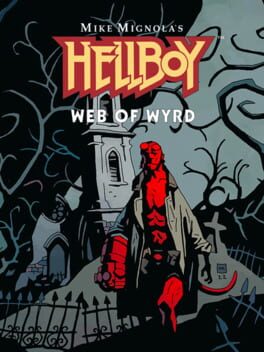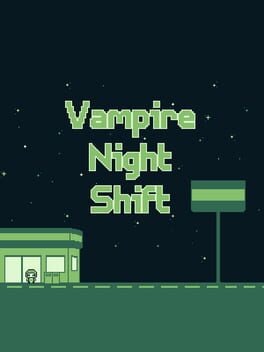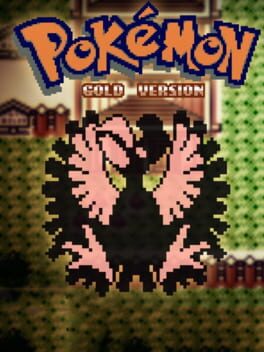tharandur
BACKER
9 reviews liked by tharandur
Stacklands
2022
What starts with a "look, a cute resource management game with cards" ends with hours of entertainment in a game that, behind a simple interface and game loop, hides an addictive loop that shines specially in the first few hours of a run.
It's fast-paced, and you can feel the pressure at the beginning to get enough resources to survive another day. And another day, and another, and... And you have spent hours playing without noticing.
The most notable aspect is how it has implemented the process of discovering new recipes. Maybe one of your villagers find an idea while exploring the mountains. Or maybe you have decided to try what happens if you stack a berry and an apple together.
The late game may feel a bit more repetitive, but it's a game definitely worth trying, and ideal for playing in a portable device.
It's fast-paced, and you can feel the pressure at the beginning to get enough resources to survive another day. And another day, and another, and... And you have spent hours playing without noticing.
The most notable aspect is how it has implemented the process of discovering new recipes. Maybe one of your villagers find an idea while exploring the mountains. Or maybe you have decided to try what happens if you stack a berry and an apple together.
The late game may feel a bit more repetitive, but it's a game definitely worth trying, and ideal for playing in a portable device.
Balatro
2024
In need of serotonin? Find a combination of jokers that, together with the rest of the power ups you have gotten, allows you to break the game, and watch the score going up while a fire effect tells you that you did it.
Balatro is perfect, is balanced, is not frustrating. The game loop forces you to adapt, to try new things, to find new strategies, just because it is FUN!! A game that you don't finish, a game you have in your library and play while you are eating.
A timeless hit.
Balatro is perfect, is balanced, is not frustrating. The game loop forces you to adapt, to try new things, to find new strategies, just because it is FUN!! A game that you don't finish, a game you have in your library and play while you are eating.
A timeless hit.
The same fun to play game, in a smaller space, with a more linear pacing, which makes it WAY better.
It solves all the narrative problems I experienced with the first one. Now your decisions matter, now it's hard to make them. The first mission is thrilling as no other in the game. It has something to say when it talks about politics, it has something to say when it talks about humans. Honor, survival, duty...
Endure and survive. I was going to say that I wish that all the game was like the DLC, but probably what makes the DLC better is it being a shorter experience. I don't know if it's enough to make you play the game, but definitely makes it way better.
It solves all the narrative problems I experienced with the first one. Now your decisions matter, now it's hard to make them. The first mission is thrilling as no other in the game. It has something to say when it talks about politics, it has something to say when it talks about humans. Honor, survival, duty...
Endure and survive. I was going to say that I wish that all the game was like the DLC, but probably what makes the DLC better is it being a shorter experience. I don't know if it's enough to make you play the game, but definitely makes it way better.
Bloom
2022
This is a difficult one for me to review, there are things that love about Bloom but I also had many issues with it.
Firstly, the things I liked - the games atmosphere and style are great, they are clearly going for a sort of lo-fi chill mood here and they absolutely nail it. The pixel art looks fantastic on the Playdate, the two areas in the game are beautiful and I love the way little parts of it change depending on what's going on in the world. The way you interact with the game world, through the character's phone essentially, is an interesting choice and gives the game a sort of voyeuristic feel - you aren't really playing as the main character, rather it feels like you're spying on her through her phone. There are moments in the story where this dynamic caused me some anxiety, and I think this was deliberate and effective. The side activities on the phone are also quite fun, the little asteroids game is great and the collectible figures are again very detailed and charming.
The characters are generally quite memorable, and there are some nice little story arcs that play out throughout the narrative. I felt like the post-game story was a lot better in this regard - it didn't feel like it was trying to create any conflict or tension, just a pleasant slice of life.
Now, for the negatives - the flower "farming" portion of the game is so trivial as to be almost pointless. From what I could tell there is no strategy at all - you unlock more valuable flowers as the story progresses, and there is no point planting anything other than those.
The amount of money you accrue also reaches comical levels, with "rent payments" big enough to buy entire mansions by the end of the game. There is lots of scope for a more rewarding system here, like needing to maintain a steady supply of each flower, or weather conditions affecting what you can grow. The rent payments didn't really even need to change that much, it could have just been that you need to keep paying the same amount instead of the ludicrously ballooning costs.
In terms of the text messaging, you are presented with a choice of what to say for every message - but it became clear early on that this has no effect at all on the events of the game. I'm quite sure that most if not all of your responses don't even affect the response you get, as many times I felt like the response I received was a better match for the option I didn't pick. The "illusion of choice" here is barely an illusion at all, there might as well just have been a "progress dialog" button instead.
Finally, this one is a bit more personal but the main story wasn't all that satisfying for me. I will discuss the story very broadly here, I don't think it constitutes spoilers but you may want to stop reading if you are extremely spoiler-averse!
I felt like the main character made many poor decisions, but never really suffered any meaningful consequences from them or learned any lessons. She came across as dishonest and self-absorbed, and in the game she never really deals with any major fallout as a result of this.. things just kinda solve themselves around her. The story also sets up various potential plot points that just never really pan out at all. In a sense I think this is quite true to real life, many people do act like this and lots of things just happen with no consequences - but as a story everything just ends up feeling somewhat pointless.
Firstly, the things I liked - the games atmosphere and style are great, they are clearly going for a sort of lo-fi chill mood here and they absolutely nail it. The pixel art looks fantastic on the Playdate, the two areas in the game are beautiful and I love the way little parts of it change depending on what's going on in the world. The way you interact with the game world, through the character's phone essentially, is an interesting choice and gives the game a sort of voyeuristic feel - you aren't really playing as the main character, rather it feels like you're spying on her through her phone. There are moments in the story where this dynamic caused me some anxiety, and I think this was deliberate and effective. The side activities on the phone are also quite fun, the little asteroids game is great and the collectible figures are again very detailed and charming.
The characters are generally quite memorable, and there are some nice little story arcs that play out throughout the narrative. I felt like the post-game story was a lot better in this regard - it didn't feel like it was trying to create any conflict or tension, just a pleasant slice of life.
Now, for the negatives - the flower "farming" portion of the game is so trivial as to be almost pointless. From what I could tell there is no strategy at all - you unlock more valuable flowers as the story progresses, and there is no point planting anything other than those.
The amount of money you accrue also reaches comical levels, with "rent payments" big enough to buy entire mansions by the end of the game. There is lots of scope for a more rewarding system here, like needing to maintain a steady supply of each flower, or weather conditions affecting what you can grow. The rent payments didn't really even need to change that much, it could have just been that you need to keep paying the same amount instead of the ludicrously ballooning costs.
In terms of the text messaging, you are presented with a choice of what to say for every message - but it became clear early on that this has no effect at all on the events of the game. I'm quite sure that most if not all of your responses don't even affect the response you get, as many times I felt like the response I received was a better match for the option I didn't pick. The "illusion of choice" here is barely an illusion at all, there might as well just have been a "progress dialog" button instead.
Finally, this one is a bit more personal but the main story wasn't all that satisfying for me. I will discuss the story very broadly here, I don't think it constitutes spoilers but you may want to stop reading if you are extremely spoiler-averse!
I felt like the main character made many poor decisions, but never really suffered any meaningful consequences from them or learned any lessons. She came across as dishonest and self-absorbed, and in the game she never really deals with any major fallout as a result of this.. things just kinda solve themselves around her. The story also sets up various potential plot points that just never really pan out at all. In a sense I think this is quite true to real life, many people do act like this and lots of things just happen with no consequences - but as a story everything just ends up feeling somewhat pointless.
Hi-Fi Rush
2023
I love both action games and rhythm games, so I thought HI-Fi Rush would be perfect for me when I saw its genre mashing gameplay and vibrant artstyle. But as much as I wanted to enjoy it, I could never really get into a groove with this game because I was constantly hurdling over little annoyances and interruptions in order to get to the fun parts. I still stuck around for the delightful spectacle and animations, but overall it ended up being a near miss for me.
The main issue was the very slow buildup of mechanics and difficulty. The elongated tutorial and very basic early game probably helped to introduce this unique genre mixture to many players, but it didn’t quite work for me. Hours into Hi-Fi Rush, I was still waiting for the gameplay to drop the beat and actually start. I was already half way through the game by the time the combat ramped up enough to be interesting and challenging. Even then, the good combat sections tended to be too short for my tastes, frequently interrupted by pointless dialogue and very clunky platforming.
I also disliked that Chai was always hitting things on beat even when my inputs were off. This might be an odd complaint, but I wanted to easily see what I was doing wrong when I wasn’t getting the “good” or “perfect” beats. Was I too slow with that attack, or too fast? I couldn’t know, but it also didn’t matter because Chai was doing his rock star thing regardless of my mistakes. The guardrails eliminated the lows of defeat, but also flattened the highs of victory.
After the credits rolled I did consider getting into the new game+ with maybe a bump in difficulty, but I realized I’d have to endure the terrible story again. Nothing in the writing worked for me. The humor rarely landed, the characters were awfully two dimensional, and Chai was an embodiment of the insufferable “idiot hero” trope. It would’ve been fine if the dialogue was contained in easily skippable cutscenes and I could forget about the characters during gameplay. But no, the chatter was constant, while I just wanted to listen to music and smash some robots.
So forgoing the new game+, I gave the arcade modes a try. These were actually pretty fun, and were closer to the experience I was looking for from the beginning. No interruptions, no platforming, just pure rhythm combat. I didn’t get too far into it because I was ready to move on to other games by then, but if I ever went back to HI-Fi Rush again, I’d be sticking to that little arcade machine.
The main issue was the very slow buildup of mechanics and difficulty. The elongated tutorial and very basic early game probably helped to introduce this unique genre mixture to many players, but it didn’t quite work for me. Hours into Hi-Fi Rush, I was still waiting for the gameplay to drop the beat and actually start. I was already half way through the game by the time the combat ramped up enough to be interesting and challenging. Even then, the good combat sections tended to be too short for my tastes, frequently interrupted by pointless dialogue and very clunky platforming.
I also disliked that Chai was always hitting things on beat even when my inputs were off. This might be an odd complaint, but I wanted to easily see what I was doing wrong when I wasn’t getting the “good” or “perfect” beats. Was I too slow with that attack, or too fast? I couldn’t know, but it also didn’t matter because Chai was doing his rock star thing regardless of my mistakes. The guardrails eliminated the lows of defeat, but also flattened the highs of victory.
After the credits rolled I did consider getting into the new game+ with maybe a bump in difficulty, but I realized I’d have to endure the terrible story again. Nothing in the writing worked for me. The humor rarely landed, the characters were awfully two dimensional, and Chai was an embodiment of the insufferable “idiot hero” trope. It would’ve been fine if the dialogue was contained in easily skippable cutscenes and I could forget about the characters during gameplay. But no, the chatter was constant, while I just wanted to listen to music and smash some robots.
So forgoing the new game+, I gave the arcade modes a try. These were actually pretty fun, and were closer to the experience I was looking for from the beginning. No interruptions, no platforming, just pure rhythm combat. I didn’t get too far into it because I was ready to move on to other games by then, but if I ever went back to HI-Fi Rush again, I’d be sticking to that little arcade machine.
Donkey Kong
1994
Recommended by Sonique as part of this list.
It's a name so iconic it's transcended its arcade roots: Donkey Kong. The classic tale of Italian vs Primate, and the shenanigans that ensue henceforth, involving barrels, sentient fireballs and lots of ladders, and for the first four levels of Donkey Kong (94'), you're lead to believe that this handheld replica is more of the same, until DK gets right back up when the game should be over and flees to the big city with Pauline in tow. A single cutscene shows you the bread and butter gameplay loop: bring the key to the door to advance. Thus does 94' reveal itself not as duplication, but as evolution.
The arcade philosophy is one that was largely bred by circumstance, of technological limits and economic goals: to make the most of what you have, you encourage replayability, skill, and mastery above all else. It's a philosophy considered niche by most but lives on in many forms, from character action games to the entirety of the shmup genre, but it has an unlikely relative in the puzzle genre. Puzzles may not have the replayability aspect due to the inherent oneness of the solution, but they emphasize similar values: skill and mastery. Learning Puyo chains in Puyo Puyo, or spacial awareness in Tetris, the idea of having a foundation that requires skill and knowledge for the player to fully expound upon. In this sense, the evolution of Arcade to Puzzle-Platformer in 94' is the best possible step Nintendo could have taken with the idea.
Making a handheld game inherently changes the game design philosophy you approach a project with, and this is where 94's strengths truly shine. The levels are all relatively bite-sized, with time limits rarely going over the three-minute mark, always focused on the main goal of bringing a comically-large key to the locked door in each level to progress, and are always clustered together in groups of 4 (3 regular levels and a fight against DK himself) before allowing you to save your game. Each cluster of levels is capped off with a cutscene that showcases a new mechanic that will be used in the next level cluster going forward, most of which lift directly from older Donkey Kong entries, from the hammers in the original arcade title, to the vine climbing mechanics of Junior (and even the appearance of the little rascal to annoy you from time to time). 94' is always introducing new mechanics, new level structures, new gimmicks to play around with and test your puzzle-solving abilities all the way until the very end, where it unfortunately falters by turning into a precision platformer gauntlet (not an inherently bad idea, Mario controls great and is about as nimble as he would be in 96's Super Mario 64, but it really downplays the strengths exemplified in the earlier worlds).
94' is a masterclass of handheld game design, a prime example of a pick up and play title that would inspire both future series such as the Mario vs Donkey Kong series (an obvious spiritual successor to 94'), as well as other puzzle platformers that would come down the line, and it's clear with titles like Donkey Kong 94' why Nintendo is considered one of the best when it comes to platformer game design.
It's a name so iconic it's transcended its arcade roots: Donkey Kong. The classic tale of Italian vs Primate, and the shenanigans that ensue henceforth, involving barrels, sentient fireballs and lots of ladders, and for the first four levels of Donkey Kong (94'), you're lead to believe that this handheld replica is more of the same, until DK gets right back up when the game should be over and flees to the big city with Pauline in tow. A single cutscene shows you the bread and butter gameplay loop: bring the key to the door to advance. Thus does 94' reveal itself not as duplication, but as evolution.
The arcade philosophy is one that was largely bred by circumstance, of technological limits and economic goals: to make the most of what you have, you encourage replayability, skill, and mastery above all else. It's a philosophy considered niche by most but lives on in many forms, from character action games to the entirety of the shmup genre, but it has an unlikely relative in the puzzle genre. Puzzles may not have the replayability aspect due to the inherent oneness of the solution, but they emphasize similar values: skill and mastery. Learning Puyo chains in Puyo Puyo, or spacial awareness in Tetris, the idea of having a foundation that requires skill and knowledge for the player to fully expound upon. In this sense, the evolution of Arcade to Puzzle-Platformer in 94' is the best possible step Nintendo could have taken with the idea.
Making a handheld game inherently changes the game design philosophy you approach a project with, and this is where 94's strengths truly shine. The levels are all relatively bite-sized, with time limits rarely going over the three-minute mark, always focused on the main goal of bringing a comically-large key to the locked door in each level to progress, and are always clustered together in groups of 4 (3 regular levels and a fight against DK himself) before allowing you to save your game. Each cluster of levels is capped off with a cutscene that showcases a new mechanic that will be used in the next level cluster going forward, most of which lift directly from older Donkey Kong entries, from the hammers in the original arcade title, to the vine climbing mechanics of Junior (and even the appearance of the little rascal to annoy you from time to time). 94' is always introducing new mechanics, new level structures, new gimmicks to play around with and test your puzzle-solving abilities all the way until the very end, where it unfortunately falters by turning into a precision platformer gauntlet (not an inherently bad idea, Mario controls great and is about as nimble as he would be in 96's Super Mario 64, but it really downplays the strengths exemplified in the earlier worlds).
94' is a masterclass of handheld game design, a prime example of a pick up and play title that would inspire both future series such as the Mario vs Donkey Kong series (an obvious spiritual successor to 94'), as well as other puzzle platformers that would come down the line, and it's clear with titles like Donkey Kong 94' why Nintendo is considered one of the best when it comes to platformer game design.
Transistor
2014
Transistor was quite an undercooked experience to me. I loved the stunning visuals and the serene soundtrack, but the story lacked depth and the gameplay wasn’t engaging enough.
What was this game trying to say? It promised a lot, but it couldn’t live up to it since mid-game.
I still had my fun with this game and only had to pay four bucks, so that was a steal anyway.
What was this game trying to say? It promised a lot, but it couldn’t live up to it since mid-game.
I still had my fun with this game and only had to pay four bucks, so that was a steal anyway.
Transistor
2014
Live A Live
2022
Live A Live has an extreme overreliance on tropes. I've seen people call this game "a love letter to JRPGs", but really, it feels more like a love letter to classic films, shoddily incorporating some of their story elements and aesthetics into each vignette-like story path. When you take away the poorly rehashed film stories, you're left with a game that never commits to any of its mechanics.
The battle system had the opportunity to shine, but it never truly excelled. It was a genuinely cool idea: a grid-based battlefield in which each protagonist has a different moveset and playstyle. There were plenty of status effects, and you could also affect certain grid tiles with statuses too. There were a bunch of different move "types", indicated by a little symbol next to the move's name. Some enemies had weaknesses and resistances that the player could exploit as well.
This seems all well and good, right? But the truth is, the effect these mechanics had on the gameplay was so incredibly minimal. Sure, each protagonist has different movesets. But the difference in "playstyle" is negligible. Resistances and weaknesses could be totally ignored in favor of raw damage. I hardly ever found myself resorting to any actual strategy when I was in battle. And the animations get to be super long, especially when grinding. There's no way to skip or speed them up. Not only did the game not explain the potency of back attacks, but there was little incentive to actually walk behind an enemy because their action bar would fill up. Physical and special attacks were also never explained to the player. The stats screen has separate stats for attack, phys. attack, and sp. attack, which makes no sense to me.
In general, the action bar never made sense to me. Counterattacks from enemies were seemingly arbitrary. And often times, after you attacked an enemy, their action bar would completely fill up (even if there were others with full bars) and immediately act, but not as a counterattack. The action bars were tiny in the UI and the game never quantified how much an action would fill the bars of enemies. Damage was never quantified either. All attack damage was classified as one of the following: Low, Medium, High, and Massive. Not only does this ruin any possible tactical depth, but it can be super misleading because multi-hit moves still could have low damage, and non-damaging moves like sleeps were still classified as low damaging. This also applied to charged moves - charge time was classified as either Short, Medium, or Long. And there was no visual or numerical quantifier to indicate to the player how long that actually is. Considering that different characters have different speed stats, there is truly no way any player could rely on these mechanics to make tactical decisions. Statuses and secondary effects had a seemingly random chance of occurring after attacks and the potency of different statuses varied wildly. Paralysis was insanely good, as it allowed you to take as many actions until the enemy recovered (or vice versa). Poison was so bad, the chip damage was sometimes in the single digits. Fortunately, there was an easy-to-access battle glossary of terms and symbols, but I found myself not even needing it due to how shallow and meaningless the mechanics are. If you just choose the high damaging moves, you will reliably win 99% of all battles you engage in, assuming you aren't in a grindy chapter and underleveled.
I think it makes sense to go through each chapter individually and give my thoughts on it. However, I want to make a disclaimer. Each of these chapters wears their influences on their sleeves, but I may have not engaged with the source material that they're referencing. For example, I have never seen 2001: A Space Odyssey or any Clint Eastwood cowboy movie. Because these film tropes are so widespread in this day and age, I don't think it should be a problem.
Prehistory
It seems like every chapter in the game has certain quirks to differentiate itself from the others. I'll get into each chapter's unique quirks as I go on, but in the case of Prehistory, the most obvious one is the fact that there's no dialogue at all. Any interactions onscreen are shown with little symbols, grunts, and sprite animations. And I just want to say that this was a colossal waste of potential. If there's an entire story with no dialogue, it would make sense to stimulate the players' other senses. This is even brought up in Pogo's theming, with his heightened smell and emphasis on instinct. But the game never properly took advantage of the visual nor audio effects. There's a few moments in the whole game when there are some really beautiful camera angles. One such instance is when The Sundown Kid first rides into town, another is during the anime opening of the Near Future. Prehistory never engages the visual medium in a meaningful way, when it was the chapter that needed it most. This also means that there's essentially no story here for me to speak of. There's the tropes of cavemen coexisting with dinosaurs, human sacrifice, and some of the worst comic relief I've ever witnessed in a video game, chock full of poop jokes and pink monkeys so the game makes absolutely sure that you know that the boy monkey is having sex with the girl monkeys. Gameplay wise, I actually really like the scent gimmick, even if it was a little confusing at first. It provides a happy medium for random encounters, and made navigating the open areas way more tolerable. The side objectives, like in every chapter, are absolutely awful. In order to find a special item and fight a secret boss, you have to press A in front of a rock 100 times. If you mess up, you have to restart. I tried fighting the mammoth secret boss but it was so bulky that I just gave up without beating it. Grinding yielded miniscule amounts of experience so I was not going to spend any more time on the chapter than I already did. Prehistory is probably my least favorite chapter. The story is nonexistent, the "comic relief" is terrible, and it wasn't ever fun for me. The battle theme was really good, though.
Imperial China
A predictable story with an unpredictable gameplay quirk that hurt the player. The story, while at the very least existing this time around, was definitely one I've seen many times before. The Shifu was the hero's journey mentor for three misfit students. What I didn't expect, is that you're only allowed to have one of them live. I trained the students equally during the training portion, which was a mistake. Yun was my successor, not that it made a significant difference in story nor gameplay. Gameplay wise, it's nothing special otherwise. The story is not only cliché kung fu hero's journey, but is also a flat out incomplete arc. Yun during the final battle acts like he was friends with Lei and Hong, but there was never any positive interaction to speak of. He didn't go through any trials aside from his training, he and the Shifu immediately left to get revenge. The only remotely interesting plot point was the fact that the protagonist was the Shifu instead of a student. Otherwise, it just rehashes a common kung fu movie plotline without any of the character development or worldbuilding that's present in those films. Let the record show that I fell asleep once while playing this chapter.
Twilight of Edo Japan
This is one of the most gameplay heavy chapters, and I personally think it suffers as a result. I was initially a fan of having pacifist/genocide-type routes. I went in planning to do a pacifist run, but that was quickly quashed once I got ahold of the stealth mechanic and password system. There were just so many potential mistakes a player could make, so I opted to do the genocide-type run instead. I failed. I followed a guide (which was annoying as hell by the way) and I guess I accidentally killed a single maiden, because you aren't able to get all 100 kills if you don't first leave all of them alive until the end. The last maiden that only appears under those circumstances won't show up otherwise, and didn't for me. I don't particularly regret what I did, because gaining experience would be even more of a bitch if I did the pacifist run (you have to grind against spirits in one area for a really long time!). Even killing as many NPCs as I saw (my final kill count was 80), combat was just as monotonous as ever. Story was super light and insignificant. The prisoner wasn't expanded on much and we never learn his real name iirc. There were multiple secret bosses which I think is super neat but I didn't go for them because I was so burned out already having been in ~EIGHTY fights. Exploring a labyrinth-like castle was also neat but the password rotation, annoying stealth mechanics, and overwhelming amount of NPCs and insignificant dead ends made it ultimately feel like a big chore. The game's mechanics seem to constantly be at odds with each other.
The Wild West
Still a mixed bag, but a significant improvement in the narrative department, and much less intrusive, at the very least, in the gameplay department. The story is still super cliché, as a simplistic nod to classic cowboy movies. An outlaw and a bounty hunter make an "unexpected" team in order to fight a greater evil and protect the town. It's totally unoriginal, but I still very much appreciate the voice work. It's some of the best of the game's voice acting. There were some great performances. I was way more invested in the characters here than most other chaptersalthough that's probably because I was heavily invested in the homoerotic tension between The Sundown Kid and Mad Dog. After the story cutscenes end, you're pushed into a time-sensitive preparation mode, where you have to efficiently navigate to the proper town buildings, pick up the necessary items, and give them back to the people at the saloon to set up. After 8 bells ring, your time is up. This was not fun at all. I don't see how anyone had fun running around pressing A in front of items, only to rush back and navigate menus. The benefit of doing this is that you'll have less enemies to fight during the boss battle. Fortunately, this section isn't incredibly intrusive, so I still think that this chapter is one of the better ones.
Present Day
What the hell? Where's the story? There's literally no story here, aside from a Rocky-esque opening scene. The final boss comes out of nowhere, and his motives are nonexistent. You do a handful of battles against other fighters, and then fight the final boss. That's literally it. Masaru's gimmick is that he learns the moves of the other fighters once he gets hit by them. He cannot level up, and is capped at level TWO. This isn't a problem in his own chapter, but oh boy will it be later. I gave up on learning all of the moves because there was a certain boss who refused to use Worldbreaker's Wrath on me after several minutes of trying. This isn't the end of the world, because all moves you miss can be learned through level up later - but it was still annoying trying to learn that move for a while to no avail. I have nothing else to say about this chapter.
The Near Future
What it does stylistically is overshadowed by the clunkiness of everything else. The classic anime-style opening was incredibly charming! I thought Akira’s story was pretty uninteresting. The amount of times that they play the mind-reading sound effect is sickening lmfao. Having a robot in the party was kinda cool, I guess. Again, there are some really cool looking scenes, like when Akira, the doctor, and the robot look up at the towering mech. This just reinforces my point that the game had the capacity to look way nicer than it does most of the time. The sci-fi/religious twist with the final boss and giant mech were cool, I will admit. Infiltrating the laboratory felt cumbersome. Whatever, at least Akira’s attack names like “Mother’s Shame” were kinda funny.
The Distant Future
This is the only chapter in LIVE A LIVE that successfully subverts and deconstructs the film tropes that it’s inspired by. With a mix between 2001: A Space Odyssey and Alien, The Distant Future places OD-10 in the role of the rogue AI. What I find interesting in the way that this chapter is presented, is that the main character is also a robot. Cube is a wonderfully designed adorable character, and his storytelling as a silent protagonist is great. Contrasting Kato’s nurturing characteristics with the toxic love triangle aboard the ship portrays the complexity of human nature. Using a robot to do this was very smart. It also helps that there are no mandatory battles aside from the final boss, which is an incredibly easy fight. The Captain Square optional battle challenges were underwhelming, as it required finding a secret in order to save progress, and there was no reward for finishing it. I also wish Cube got a proper battle theme for his chapter. The only other unique game mechanic was…a crowbar. Uh, okay? I mean, navigating the halls with the alien creature was definitely creepy, so I guess I don’t mind. The Distant Future also has some great voice acting. By far the best storytelling in the entire game, and the only chapter to add a new perspective on the influences it wears on its sleeve. It’s a shame that they had to take the gameplay out entirely to make me feel this way.
The Middle Ages
This chapter features an actual overworld, which is kinda cool. I did not get attached to a single character, and I found it cheesy that Oersted got the girl after winning a tournament. The girl was captured, he gathered a party, and rescued her. Turns out he was betrayed, and he turned into the joker. It was an interesting twist that I didn’t expect, but I also didn’t sympathize or feel anything for him. He felt entitled to his girl, and when she was stolen and betrayed, he acted like the entire world was against him. Turning into/working with Odio didn’t really make sense to me for multiple reasons. The whole time travel thing in order to be the boss of each respective era/chapter already requires suspension of disbelief, but one would think that the actions of the other characters would restore Oersted’s faith in humanity. Wasn’t the Sundown Kid placed in the exact same situation, where he was ostracized as an outlaw, but did the right thing anyways? To be completely honest, Oersted could have been a sympathetic villain but instead ended up acting like an incel crybaby. Giving the villain his own origin story through a full chapter in the game could have been a great way to develop him, but the writers were too focused on falling into high fantasy tropes to write a good character.
Final Showdown
This sucked. I chose The Sundown Kid as my starting character because I heard online that he was the most troublesome to recruit. Considering this game wastes enough of the player’s time in this sequence, I opted to nip it in the bud. Otherwise, I would have picked Cube. Speaking of Cube, I was expecting the robot upgrade parts from Akira’s story to transfer to my inventory once I recruited him, but they weren’t there. This is partially the IGN guide’s fault for providing false information, but apparently the original SNES version did let the player carry over the robot upgrades? And they decided to remove that feature in this game? I only found one upgrade part through regular battles in the showdown sequence, but whatever. There was an extreme level imbalance between the other playable characters. Like I said earlier, Masaru was level TWO, and learns no moves that he couldn’t learn during his chapter. Sundown Kid did actually learn some really cool attacks. If you didn’t grind a ton with Oboromaru in his chapter, prepare to suffer. Overall, no interesting story bits were raised during the preparation section.
When finally challenging Oersted, it was flashy and I appreciated the presentation. But once again, the story bordered on incoherent. You redo boss fights, until you get a multiphase final fight with Odio. It’s very flashy, but all for show. It was hard to suspend disbelief when seeing all of the characters from each individual era stand next to each other, and Odio’s motives and logic were of course never explained.
The game’s story never stepped out of the shadows it basked in, and it shows. Its mechanics showed promise but ultimately failed to deliver, there were several questionable design choices, almost all of the individual stories were watered down film tropes with no added nuance, and the final sequence that tied them together couldn’t coherently explain why this was worth all the trouble. LIVE A LIVE’s occasional visual charm, good voice acting, and nostalgia factor couldn’t save it from its pure mediocrity. As a diehard Octopath fan, I can't believe people prefer this game over it; OT has a deep customizable job system with hidden jobs and one of the best soundtracks of all time. LIVE A LIVE's battle mechanics, even when scripted, are absolutely incomparable with a soundtrack that's only good and a story that's similarly cringeworthy. Put some respect on Octopath's name!
TLDR; one star for Cube, one star for gay cowboys
The battle system had the opportunity to shine, but it never truly excelled. It was a genuinely cool idea: a grid-based battlefield in which each protagonist has a different moveset and playstyle. There were plenty of status effects, and you could also affect certain grid tiles with statuses too. There were a bunch of different move "types", indicated by a little symbol next to the move's name. Some enemies had weaknesses and resistances that the player could exploit as well.
This seems all well and good, right? But the truth is, the effect these mechanics had on the gameplay was so incredibly minimal. Sure, each protagonist has different movesets. But the difference in "playstyle" is negligible. Resistances and weaknesses could be totally ignored in favor of raw damage. I hardly ever found myself resorting to any actual strategy when I was in battle. And the animations get to be super long, especially when grinding. There's no way to skip or speed them up. Not only did the game not explain the potency of back attacks, but there was little incentive to actually walk behind an enemy because their action bar would fill up. Physical and special attacks were also never explained to the player. The stats screen has separate stats for attack, phys. attack, and sp. attack, which makes no sense to me.
In general, the action bar never made sense to me. Counterattacks from enemies were seemingly arbitrary. And often times, after you attacked an enemy, their action bar would completely fill up (even if there were others with full bars) and immediately act, but not as a counterattack. The action bars were tiny in the UI and the game never quantified how much an action would fill the bars of enemies. Damage was never quantified either. All attack damage was classified as one of the following: Low, Medium, High, and Massive. Not only does this ruin any possible tactical depth, but it can be super misleading because multi-hit moves still could have low damage, and non-damaging moves like sleeps were still classified as low damaging. This also applied to charged moves - charge time was classified as either Short, Medium, or Long. And there was no visual or numerical quantifier to indicate to the player how long that actually is. Considering that different characters have different speed stats, there is truly no way any player could rely on these mechanics to make tactical decisions. Statuses and secondary effects had a seemingly random chance of occurring after attacks and the potency of different statuses varied wildly. Paralysis was insanely good, as it allowed you to take as many actions until the enemy recovered (or vice versa). Poison was so bad, the chip damage was sometimes in the single digits. Fortunately, there was an easy-to-access battle glossary of terms and symbols, but I found myself not even needing it due to how shallow and meaningless the mechanics are. If you just choose the high damaging moves, you will reliably win 99% of all battles you engage in, assuming you aren't in a grindy chapter and underleveled.
I think it makes sense to go through each chapter individually and give my thoughts on it. However, I want to make a disclaimer. Each of these chapters wears their influences on their sleeves, but I may have not engaged with the source material that they're referencing. For example, I have never seen 2001: A Space Odyssey or any Clint Eastwood cowboy movie. Because these film tropes are so widespread in this day and age, I don't think it should be a problem.
Prehistory
It seems like every chapter in the game has certain quirks to differentiate itself from the others. I'll get into each chapter's unique quirks as I go on, but in the case of Prehistory, the most obvious one is the fact that there's no dialogue at all. Any interactions onscreen are shown with little symbols, grunts, and sprite animations. And I just want to say that this was a colossal waste of potential. If there's an entire story with no dialogue, it would make sense to stimulate the players' other senses. This is even brought up in Pogo's theming, with his heightened smell and emphasis on instinct. But the game never properly took advantage of the visual nor audio effects. There's a few moments in the whole game when there are some really beautiful camera angles. One such instance is when The Sundown Kid first rides into town, another is during the anime opening of the Near Future. Prehistory never engages the visual medium in a meaningful way, when it was the chapter that needed it most. This also means that there's essentially no story here for me to speak of. There's the tropes of cavemen coexisting with dinosaurs, human sacrifice, and some of the worst comic relief I've ever witnessed in a video game, chock full of poop jokes and pink monkeys so the game makes absolutely sure that you know that the boy monkey is having sex with the girl monkeys. Gameplay wise, I actually really like the scent gimmick, even if it was a little confusing at first. It provides a happy medium for random encounters, and made navigating the open areas way more tolerable. The side objectives, like in every chapter, are absolutely awful. In order to find a special item and fight a secret boss, you have to press A in front of a rock 100 times. If you mess up, you have to restart. I tried fighting the mammoth secret boss but it was so bulky that I just gave up without beating it. Grinding yielded miniscule amounts of experience so I was not going to spend any more time on the chapter than I already did. Prehistory is probably my least favorite chapter. The story is nonexistent, the "comic relief" is terrible, and it wasn't ever fun for me. The battle theme was really good, though.
Imperial China
A predictable story with an unpredictable gameplay quirk that hurt the player. The story, while at the very least existing this time around, was definitely one I've seen many times before. The Shifu was the hero's journey mentor for three misfit students. What I didn't expect, is that you're only allowed to have one of them live. I trained the students equally during the training portion, which was a mistake. Yun was my successor, not that it made a significant difference in story nor gameplay. Gameplay wise, it's nothing special otherwise. The story is not only cliché kung fu hero's journey, but is also a flat out incomplete arc. Yun during the final battle acts like he was friends with Lei and Hong, but there was never any positive interaction to speak of. He didn't go through any trials aside from his training, he and the Shifu immediately left to get revenge. The only remotely interesting plot point was the fact that the protagonist was the Shifu instead of a student. Otherwise, it just rehashes a common kung fu movie plotline without any of the character development or worldbuilding that's present in those films. Let the record show that I fell asleep once while playing this chapter.
Twilight of Edo Japan
This is one of the most gameplay heavy chapters, and I personally think it suffers as a result. I was initially a fan of having pacifist/genocide-type routes. I went in planning to do a pacifist run, but that was quickly quashed once I got ahold of the stealth mechanic and password system. There were just so many potential mistakes a player could make, so I opted to do the genocide-type run instead. I failed. I followed a guide (which was annoying as hell by the way) and I guess I accidentally killed a single maiden, because you aren't able to get all 100 kills if you don't first leave all of them alive until the end. The last maiden that only appears under those circumstances won't show up otherwise, and didn't for me. I don't particularly regret what I did, because gaining experience would be even more of a bitch if I did the pacifist run (you have to grind against spirits in one area for a really long time!). Even killing as many NPCs as I saw (my final kill count was 80), combat was just as monotonous as ever. Story was super light and insignificant. The prisoner wasn't expanded on much and we never learn his real name iirc. There were multiple secret bosses which I think is super neat but I didn't go for them because I was so burned out already having been in ~EIGHTY fights. Exploring a labyrinth-like castle was also neat but the password rotation, annoying stealth mechanics, and overwhelming amount of NPCs and insignificant dead ends made it ultimately feel like a big chore. The game's mechanics seem to constantly be at odds with each other.
The Wild West
Still a mixed bag, but a significant improvement in the narrative department, and much less intrusive, at the very least, in the gameplay department. The story is still super cliché, as a simplistic nod to classic cowboy movies. An outlaw and a bounty hunter make an "unexpected" team in order to fight a greater evil and protect the town. It's totally unoriginal, but I still very much appreciate the voice work. It's some of the best of the game's voice acting. There were some great performances. I was way more invested in the characters here than most other chapters
Present Day
What the hell? Where's the story? There's literally no story here, aside from a Rocky-esque opening scene. The final boss comes out of nowhere, and his motives are nonexistent. You do a handful of battles against other fighters, and then fight the final boss. That's literally it. Masaru's gimmick is that he learns the moves of the other fighters once he gets hit by them. He cannot level up, and is capped at level TWO. This isn't a problem in his own chapter, but oh boy will it be later. I gave up on learning all of the moves because there was a certain boss who refused to use Worldbreaker's Wrath on me after several minutes of trying. This isn't the end of the world, because all moves you miss can be learned through level up later - but it was still annoying trying to learn that move for a while to no avail. I have nothing else to say about this chapter.
The Near Future
What it does stylistically is overshadowed by the clunkiness of everything else. The classic anime-style opening was incredibly charming! I thought Akira’s story was pretty uninteresting. The amount of times that they play the mind-reading sound effect is sickening lmfao. Having a robot in the party was kinda cool, I guess. Again, there are some really cool looking scenes, like when Akira, the doctor, and the robot look up at the towering mech. This just reinforces my point that the game had the capacity to look way nicer than it does most of the time. The sci-fi/religious twist with the final boss and giant mech were cool, I will admit. Infiltrating the laboratory felt cumbersome. Whatever, at least Akira’s attack names like “Mother’s Shame” were kinda funny.
The Distant Future
This is the only chapter in LIVE A LIVE that successfully subverts and deconstructs the film tropes that it’s inspired by. With a mix between 2001: A Space Odyssey and Alien, The Distant Future places OD-10 in the role of the rogue AI. What I find interesting in the way that this chapter is presented, is that the main character is also a robot. Cube is a wonderfully designed adorable character, and his storytelling as a silent protagonist is great. Contrasting Kato’s nurturing characteristics with the toxic love triangle aboard the ship portrays the complexity of human nature. Using a robot to do this was very smart. It also helps that there are no mandatory battles aside from the final boss, which is an incredibly easy fight. The Captain Square optional battle challenges were underwhelming, as it required finding a secret in order to save progress, and there was no reward for finishing it. I also wish Cube got a proper battle theme for his chapter. The only other unique game mechanic was…a crowbar. Uh, okay? I mean, navigating the halls with the alien creature was definitely creepy, so I guess I don’t mind. The Distant Future also has some great voice acting. By far the best storytelling in the entire game, and the only chapter to add a new perspective on the influences it wears on its sleeve. It’s a shame that they had to take the gameplay out entirely to make me feel this way.
The Middle Ages
This chapter features an actual overworld, which is kinda cool. I did not get attached to a single character, and I found it cheesy that Oersted got the girl after winning a tournament. The girl was captured, he gathered a party, and rescued her. Turns out he was betrayed, and he turned into the joker. It was an interesting twist that I didn’t expect, but I also didn’t sympathize or feel anything for him. He felt entitled to his girl, and when she was stolen and betrayed, he acted like the entire world was against him. Turning into/working with Odio didn’t really make sense to me for multiple reasons. The whole time travel thing in order to be the boss of each respective era/chapter already requires suspension of disbelief, but one would think that the actions of the other characters would restore Oersted’s faith in humanity. Wasn’t the Sundown Kid placed in the exact same situation, where he was ostracized as an outlaw, but did the right thing anyways? To be completely honest, Oersted could have been a sympathetic villain but instead ended up acting like an incel crybaby. Giving the villain his own origin story through a full chapter in the game could have been a great way to develop him, but the writers were too focused on falling into high fantasy tropes to write a good character.
Final Showdown
This sucked. I chose The Sundown Kid as my starting character because I heard online that he was the most troublesome to recruit. Considering this game wastes enough of the player’s time in this sequence, I opted to nip it in the bud. Otherwise, I would have picked Cube. Speaking of Cube, I was expecting the robot upgrade parts from Akira’s story to transfer to my inventory once I recruited him, but they weren’t there. This is partially the IGN guide’s fault for providing false information, but apparently the original SNES version did let the player carry over the robot upgrades? And they decided to remove that feature in this game? I only found one upgrade part through regular battles in the showdown sequence, but whatever. There was an extreme level imbalance between the other playable characters. Like I said earlier, Masaru was level TWO, and learns no moves that he couldn’t learn during his chapter. Sundown Kid did actually learn some really cool attacks. If you didn’t grind a ton with Oboromaru in his chapter, prepare to suffer. Overall, no interesting story bits were raised during the preparation section.
When finally challenging Oersted, it was flashy and I appreciated the presentation. But once again, the story bordered on incoherent. You redo boss fights, until you get a multiphase final fight with Odio. It’s very flashy, but all for show. It was hard to suspend disbelief when seeing all of the characters from each individual era stand next to each other, and Odio’s motives and logic were of course never explained.
The game’s story never stepped out of the shadows it basked in, and it shows. Its mechanics showed promise but ultimately failed to deliver, there were several questionable design choices, almost all of the individual stories were watered down film tropes with no added nuance, and the final sequence that tied them together couldn’t coherently explain why this was worth all the trouble. LIVE A LIVE’s occasional visual charm, good voice acting, and nostalgia factor couldn’t save it from its pure mediocrity. As a diehard Octopath fan, I can't believe people prefer this game over it; OT has a deep customizable job system with hidden jobs and one of the best soundtracks of all time. LIVE A LIVE's battle mechanics, even when scripted, are absolutely incomparable with a soundtrack that's only good and a story that's similarly cringeworthy. Put some respect on Octopath's name!
TLDR; one star for Cube, one star for gay cowboys
